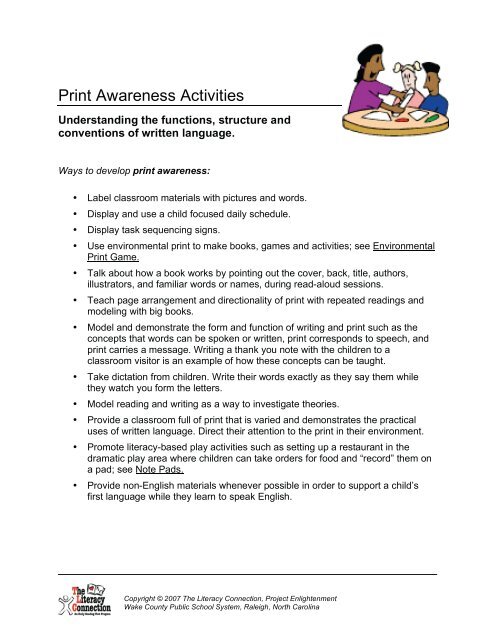Print Awareness Activities - The Literacy Connection - Wake County ...
Print Awareness Activities - The Literacy Connection - Wake County ...
Print Awareness Activities - The Literacy Connection - Wake County ...
You also want an ePaper? Increase the reach of your titles
YUMPU automatically turns print PDFs into web optimized ePapers that Google loves.
<strong>Print</strong> <strong>Awareness</strong> <strong>Activities</strong><br />
Understanding the functions, structure and<br />
conventions of written language.<br />
Ways to develop print awareness:<br />
• Label classroom materials with pictures and words.<br />
• Display and use a child focused daily schedule.<br />
• Display task sequencing signs.<br />
• Use environmental print to make books, games and activities; see Environmental<br />
<strong>Print</strong> Game.<br />
• Talk about how a book works by pointing out the cover, back, title, authors,<br />
illustrators, and familiar words or names, during read-aloud sessions.<br />
• Teach page arrangement and directionality of print with repeated readings and<br />
modeling with big books.<br />
• Model and demonstrate the form and function of writing and print such as the<br />
concepts that words can be spoken or written, print corresponds to speech, and<br />
print carries a message. Writing a thank you note with the children to a<br />
classroom visitor is an example of how these concepts can be taught.<br />
• Take dictation from children. Write their words exactly as they say them while<br />
they watch you form the letters.<br />
• Model reading and writing as a way to investigate theories.<br />
• Provide a classroom full of print that is varied and demonstrates the practical<br />
uses of written language. Direct their attention to the print in their environment.<br />
• Promote literacy-based play activities such as setting up a restaurant in the<br />
dramatic play area where children can take orders for food and “record” them on<br />
a pad; see Note Pads.<br />
• Provide non-English materials whenever possible in order to support a child’s<br />
first language while they learn to speak English.<br />
Copyright © 2007 <strong>The</strong> <strong>Literacy</strong> <strong>Connection</strong>, Project Enlightenment<br />
<strong>Wake</strong> <strong>County</strong> Public School System, Raleigh, North Carolina
Considerations for children with special needs:<br />
• Give children opportunities to explore “writing “ on the computer keyboard by<br />
using an adapted keyboard and putting the font on 72.<br />
• Be sure children have access to adapted writing tools in every center.<br />
• Have children “be a word” in a sentence by giving them an index card with one<br />
word in a sentence. Let them stand with other children to make a sentence.<br />
• Use a book on the computer with switches to turn the page. Have one of the<br />
pages appear upside down!<br />
PRINT AWARENESS RESOURCES<br />
Copyright © 2007 <strong>The</strong> <strong>Literacy</strong> <strong>Connection</strong>, Project Enlightenment<br />
<strong>Wake</strong> <strong>County</strong> Public School System, Raleigh, North Carolina











